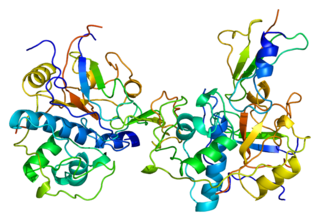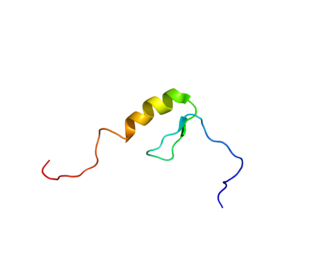
Toll-like receptor 3 (TLR3) also known as CD283 is a protein that in humans is encoded by the TLR3 gene. TLR3 is a member of the toll-like receptor family of pattern recognition receptors of the innate immune system.

Leukemia inhibitory factor, or LIF, is an interleukin 6 class cytokine that affects cell growth by inhibiting differentiation. When LIF levels drop, the cells differentiate.

Angiopoietin 1 is a type of angiopoietin and is encoded by the gene ANGPT1.

Toll-like receptor 8 is a protein that in humans is encoded by the TLR8 gene. TLR8 has also been designated as CD288. It is a member of the toll-like receptor (TLR) family.

Toll-like receptor 10 is a protein that in humans is encoded by the TLR10 gene. TLR10 has also been designated as CD290 . TLR10 has not been extensively studied because it is a pseudogene in mice, though all other mammalian species contain an intact copy of the TLR10 gene. Unlike other TLRs, TLR10 does not activate the immune system and has instead been shown to suppress inflammatory signaling on primary human cells. This makes TLR10 unique among the TLR family. TLR10 was thought to be an "orphan" receptor, however, recent studies have identified ligands for TLR10 and these include HIV-gp41. Ligands for TLR2 are potential ligands for TLR10.

HLA class II histocompatibility antigen gamma chain also known as HLA-DR antigens-associated invariant chain or CD74, is a protein that in humans is encoded by the CD74 gene. The invariant chain is a polypeptide which plays a critical role in antigen presentation. It is involved in the formation and transport of MHC class II peptide complexes for the generation of CD4+ T cell responses. The cell surface form of the invariant chain is known as CD74. CD74 is a cell surface receptor for the cytokine macrophage migration inhibitory factor (MIF).

Sal-like protein 4(SALL4) is a transcription factor encoded by a member of the Spalt-like (SALL) gene family, SALL4. The SALL genes were identified based on their sequence homology to Spalt, which is a homeotic gene originally cloned in Drosophila melanogaster that is important for terminal trunk structure formation in embryogenesis and imaginal disc development in the larval stages. There are four human SALL proteins with structural homology and playing diverse roles in embryonic development, kidney function, and cancer. The SALL4 gene encodes at least three isoforms, termed A, B, and C, through alternative splicing, with the A and B forms being the most studied. SALL4 can alter gene expression changes through its interaction with many co-factors and epigenetic complexes. It is also known as a key embryonic stem cell (ESC) factor.

Heart- and neural crest derivatives-expressed protein 2 is a protein that in humans is encoded by the HAND2 gene.

Ergosterol biosynthetic protein 28 is a protein that in humans is encoded by the ERG28 gene.

Chemokine-like factor is a protein that in humans is encoded by the CKLF gene.

Transcription factor HIVEP3 is a protein that in humans is encoded by the HIVEP3 gene.

Zinc finger protein 268 is a protein that in humans is encoded by the ZNF268 gene.

CD96 or Tactile is a protein that in humans is encoded by the CD96 gene. CD96 is a receptor protein which is expressed on T cells and NK cells and shares sequence similarity with CD226. The protein encoded by this gene belongs to the immunoglobulin superfamily. It is a type I membrane protein. The protein may play a role in the adhesion of activated T and NK cells to their target cells during the late phase of the immune response. It may also function in antigen presentation. Alternative splicing occurs at this locus and two transcript variants encoding distinct isoforms have been identified. CD96 is a transmembrane glycoprotein that has three extracellular immunoglobulin-like domains and is expressed by all resting human and mouse NK cells. CD96 main ligand is CD155. CD 96 has approximately 20% homology with CD226 and competed for binding to CD155 with CD226.

Solute carrier family 52, member 3, formerly known as chromosome 20 open reading frame 54 and riboflavin transporter 2, is a protein that in humans is encoded by the SLC52A3 gene.

Patched 2 is a protein that in humans is encoded by the PTCH2 gene.

Aconitase 1, soluble is a protein that in humans is encoded by the ACO1 gene.

Zinc finger protein 510 is a protein that in humans is encoded by the ZNF510 gene.

Solute carrier family 39 member 12 is a protein that in humans is encoded by the SLC39A12 gene.

MicroRNA let-7f-2 is a protein that in humans is encoded by the MIRLET7F2 gene.

Zinc transporter ZIP8 is a cation/bicarbonate symporter protein which in humans is encoded by the SLC39A8 gene.
















